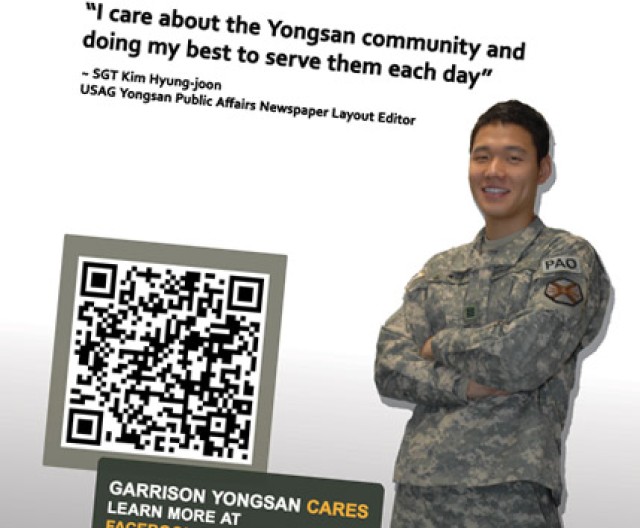
YONGSAN GARRISON, Republic of Korea -- On Tuesday, the U.S. Army Garrison Yongsan Public Affairs Office officially launched a new service that will allow community members to pull data from paper media using their smart phone or iPod Touch.
The new strategy uses a two-dimensional barcode known as QR Code that can hold messages, contact information, and most importantly, Web addresses that can be decoded automatically by the camera in an enabled handheld device.
"This technology has been around for years in Asia," said Dan Thompson, U.S. Army Garrison Yongsan Public Affairs chief. "Ever since I saw QR used in an advertisement on a bus in Mainz, Germany, I was curious how it might be applied for Army Public Affairs. After doing some research, the answer was that it could be applied quite easily."
Yongsan Public Affairs is using its new "I care" campaign, which highlights garrison employees with inspiring public service ethic, to unveil the QR codes in the base newspaper with instructions on how to use the codes.
"Our campaign features an employee and a QR code prominently displayed together in the full page paper ad," Thompson said. "When a reader scans the code, their smart phone or Ipod takes them the biography of the person featured on the page. If they do not have a wireless connection, users can still save the address and access the link later when they are connected."
With a multitude of websites offering free QR encoding, using QR technology costs virtually nothing, according to Thompson. Once the code is generated on the web, if can be copied and pasted into the design of a poster or news page.
"With the QR code, instead of paying thousands of dollars for information kiosks, you could simply make each smart phone or Ipod a kiosk," he said. "Each service provider on post could have a QR code at their reception desk that, when scanned, takes users to the Interactive Customer Evaluation page for instant feedback, lessening the demand for cumbersome and labor-intense paper tabulation."
With smart phones becoming cheaper and ubiquitous, Thompson said that this new approach could change how we use paper media.
"Yongsan plans on using these codes to link Installation Management Command Campaign Plan videos to promotional posters, make in-processing easier by putting codes in welcome centers that link to forms on the internet, and putting the codes on policy letters that will link to a command video. The possibilities are really exciting...and completely sustainable."
The application could save time and money, too, he added.
"Instead of gathering up folders full of paper promotions or trying to remember to fill out a registration form, one could simply snap the code, get the internet address for the file online, and access it later from home, possibly lessening the need for mass printings."
For now, Garrison Yongsan plans on using QR Code to make its newspaper more dynamic, such as linking paper stories to the full color images currently hosted online, or linking directly through to a live commenting area about the story in order to gain customer feedback.
"This technology is out there waiting to be used for little to no cost," Thompson said. "Whenever we can offer a better service at little to no cost while embracing smart phones, which I believe are slowly replacing traditional laptops, it is something to get excited about."

Social Sharing